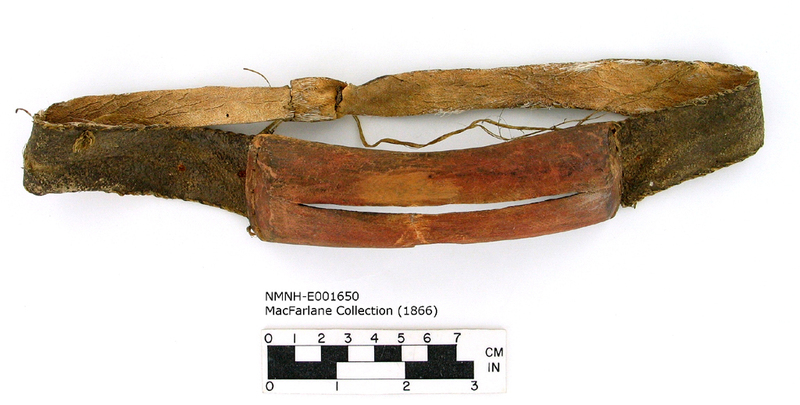The Inuvialuit Living History Project (2011)

Image of MacFarlane Collections snow goggles from the Smithsonian's National Museum of Natural History
A full description of this project in progress can be found in our 2011 Project Report: The Inuvialuit Smithsonian Project: Winter 2009-Spring 2011
During our visit at the National Museum of Natural History in 2009, elder Albert Elias described the MacFarlane Collection as a “living collection”. As curator Stephen Loring pulled intricate and beautiful items of clothing, tools, hunting, and artwork from storage, members of the project team recalled how many of these objects had once been used in practice. They also discussed how new access to artifacts in the collection will inspire the re-creation of cultural objects and other cultural activities and education programs. For our project team, the MacFarlane Collection represents “Inuvilauit Pitqusiit Inuuniarutait: Inuvialuit Living History”.
Next week I will travel to Inuvik to present our first prototype of the virtual exhibit and web-based resource Inuvialuit Pitqusiit Inuuniarutait (Inuvialuit Living History). A work in progress, the website is being designed to create access for Inuvialuit people and interested global public to the Smithsonian’s MacFarlane Collection. The website is meant to provide a view into the emerging and dynamic relationship between Inuvialuit peoples and the MacFarlane Collection, and to promote the collection as a place for learning and teaching. The website will feature teachers’ resources and interactive lesson plans tailored to meet the requirements for the Northwest Territories curriculum, so that Inuvialuit youth can reference their own culture and history online. We use artifact descriptions from the Smithsonian, and those that were developed in the course of this project, as well as video and photographs of our workshop with Inuvialuit elders, youth, cultural workers at the Smithsonian, and our team’s consultations in the Inuvialuit Settlement Region, to show how the MacFarlane collection is becoming a “living collection” once again through its reconnection to Inuvialuit people. We will use interactive maps to connect the artifact records and related community media to places in the Anderson River area, and show how knowledge of the collection is being applied in every day life. The website provides information about the history of the collection, including the biography of Roderick MacFarlane and the short life of Fort Anderson; about the Smithsonian Institution, and how it came to be in possession of these invaluable artifacts; and about repatriation, ownership, and intellectual property rights to the collection. We also want the website to reflect the collaborative spirit in which the website is being built, by including video and photographs of our production process. In addition to teaching about the collection and this project, it is our goal to create a website that can become an archive of documentation of community activities and other resources related to ongoing educational and cultural programs related to the MacFarlane Collection.
Project Team (alphabetical order)
